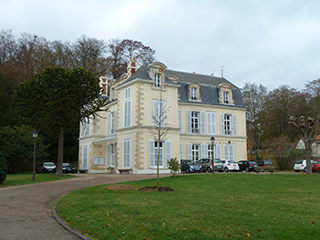Prochain point : lat="48.999303" lon="1.881173"

Town hall
A château and its grounds become a place for all
The château of the former lords ...
At this location there once stood a medieval fortified manor, below the tower erected on the feudal mound. It was close to a massive tower, the “Bertaudière”, symbol of the power of the lords of Mézy. The building with its slated roof stood at the end of a wide avenue lined with elm trees, their tops rounded by topiary. The main building was flanked by pavilions on each side. In front, on what was called the seigniorial square, stood the audience room, the prison and the gamekeeper’s house. Terraced gardens extended over ten acres, from the château to the main road.
In 1714 the estate was bought by Jacques Durand, a fermier général (a tax farmer-general). He had the tower demolished, rebuilt the house in the style of the times and had inscriptions placed on the iron railings praising country life. After 1774 the estate was owned by the Dupleix family and it is here that they received Chateaubriand on several occasions. In his "Memoirs from Beyond the Grave," he wrote in 1809: "Madame de Mézy was the novel enclosed in virtue and maternal pain." Pain from the accident of her daughter who threw herself from an upstairs window.
... becomes a place for all
In 1787 the first municipal assembly was held in Mézy-sur-Seine and 1789 saw the first elected council. Its meetings were held after mass in the church up until the nineteenth century. The town hall-school was built under the Third Republic in 1879 in rue Alfred Lasson. When the building became too small the town hall was transferred in 1984 to this property, sold to the town by the heirs of Paul Bargeton, the former mayor, and who the square is named after.





